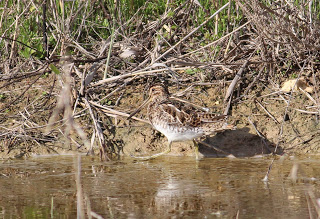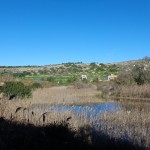Volunteering at Simar Nature Reserve
Lydia Wild
Getting up at 5 o’ clock would normally be a fearful thought for me. But I love doing physical work outside and I find working closely with nature very rewarding, so I got out of bed and enjoyed a blissful cycle to Simar nature reserve in the weak, early morning light. We had to start so early as this is the only time of the day when it’s possible to carry out work due to the intense heat.

I was helping to develop one of the islands in the middle of the pond with the warden, Charles. We paddled across the water in a small boat and I decided this was surely the best way to start the day – gliding along, listening to the end of the dawn chorus and watching the sun rise over the bay.
The previous time I volunteered we had begun levelling out a section of the island, digging with axes and spades, in order to allow it to flood when the water levels rise in the winter.
Wading birds such as Common Sandpiper (Pispisella), Common Snipe (Bekkaċċ) and Dunlin (Pispisella tad-Dabra) feed in soft soil or mud, picking out small invertebrates with their delicate bills. Flooding this section will turn it into a mini mud flat, perfect for these birds. In previous years, they have not chosen to stick around to feed – probably due to the lack of adequate space – so improving this island will encourage them to stay for a longer period.

The soil that had been dug out for the mud flat was being reused to cover a nesting bank designed for Kingfishers (Għasfur ta’ San Martin). In the wild, they usually nest in tunnels which they make into riverbanks so we have built an artificial one using rocks, soil and man-made burrows to encourage them to the reserve. They are more likely to use it if it looks like something they would normally inhabit so we spent one morning piling the soil on top to make it blend in to the natural environment.
Similarly, on Għadira Nature Reserve, pebbles have been spread on the islands to encourage Little Ringed Plovers (Monakella) to breed as they favour more sheltered, rocky landscapes to nest on. This has been very successful , with multiple plover families choosing these areas to raise their chicks.
We also moved some large branches that had been cut down and arranged them into a raft in the middle of the pond for perching birds such as Cormorants (Margun) to sunbathe and rest between hunting for fish.
It is important to manage the reserve in these ways because without human intervention, the plants and trees will take over, there will be nowhere for birds to feed or breed and invasive or non-native species would begin to spread.
The reserves provide a small safe haven for migratory species stopping over to rest and refuel and a stable environment rich in biodiversity for resident birds.
I enjoyed my time at Simar so much; it is always a welcome break from working in an office. Although the heat is insane, it’s definitely worth it to feel like I am contributing to such important work and I left feeling very satisfied, if not completely exhausted.


